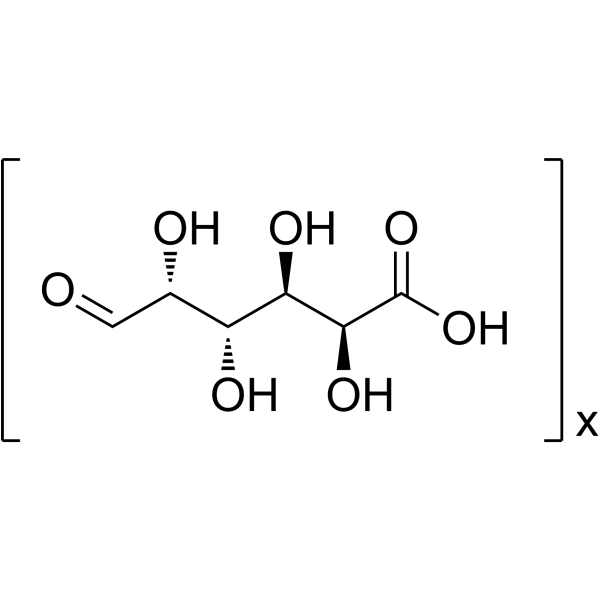Polygalacturonic acid

Polygalacturonic acid structure
|
Common Name | Polygalacturonic acid | ||
|---|---|---|---|---|
| CAS Number | 25990-10-7 | Molecular Weight | 194.139 | |
| Density | 1.7±0.1 g/cm3 | Boiling Point | 553.4±50.0 °C at 760 mmHg | |
| Molecular Formula | C6H10O7 | Melting Point | N/A | |
| MSDS | USA | Flash Point | 302.6±26.6 °C | |
|
Leaf-cutting ant fungi produce cell wall degrading pectinase complexes reminiscent of phytopathogenic fungi.
BMC Biol. 8 , 156, (2010) Leaf-cutting (attine) ants use their own fecal material to manure fungus gardens, which consist of leaf material overgrown by hyphal threads of the basidiomycete fungus Leucocoprinus gongylophorus that lives in symbiosis with the ants. Previous studies have s... |
|
|
A colorimetric method to quantify endo-polygalacturonase activity.
Enzyme Microb. Technol. 48 , 123-128, (2011) We report a new colorimetric assay to quantify endo-polygalacturonase activity, which hydrolyzes polygalacturonic acid to produce smaller chains of galacturonate. Some of the reported polygalacturonase assays measure the activity by detecting the appearance o... |
|
|
Polygalacturonase Isozymes Produced by Phomopsis cucurbitae in Relation to Postharvest Decay of Cantaloupe Fruit.
Phytopathology 87 , 1020-1025, (1997) ABSTRACT Production of polygalacturonase (PG), a cell wall-degrading enzyme, by Phomopsis cucurbitae (latent infection fungus) was studied in relation to different carbon sources and various stages of cantaloupe fruit development. P. cucurbitae produced multi... |
|
|
Purification and biochemical characterization of polygalacturonase produced by penicillium expansum during postharvest decay of 'Anjou' pear.
Phytopathology 100 , 42-48, (2010) A polygalacturonase (PG) was extracted and purified from decayed tissue of 'Anjou' pear fruit inoculated with Penicillium expansum. Ammonium sulfate precipitation, gel filtration, and cation exchange chromatography were used to purify the enzyme. Both chromat... |
|
|
Penicillium solitum produces a polygalacturonase isozyme in decayed Anjou pear fruit capable of macerating host tissue in vitro.
Mycologia 104(3) , 604-12, (2012) A polygalacturonase (PG) isozyme was isolated from Penicillium solitum-decayed Anjou pear fruit and purified to homogeneity with a multistep process. Both gel filtration and cation exchange chromatography revealed a single PG activity peak, and analysis of th... |
|
|
Optimization of pectin extraction from banana peels with citric acid by using response surface methodology.
Food Chem. 198 , 113-8, (2016) A central composite design was used to determine effects of pH (2.0-4.5), extraction temperature (70-90 °C) and time (120-240 min) on the yield, degree of methoxylation (DM) and galacturonic acid content (GA) of pectins extracted from banana peels with citric... |
|
|
Pectin: cell biology and prospects for functional analysis.
Plant Mol. Biol. 47 , 9-27, (2001) Pectin is a major component of primary cell walls of all land plants and encompasses a range of galacturonic acid-rich polysaccharides. Three major pectic polysaccharides (homogalacturonan, rhamnogalacturonan-I and rhamnogalacturonan-II) are thought to occur ... |
|
|
Polygalacturonase-inhibiting protein interacts with pectin through a binding site formed by four clustered residues of arginine and lysine.
Plant Physiol. 141 , 557-564, (2006) Polygalacturonase-inhibiting protein (PGIP) is a cell wall protein that inhibits fungal polygalacturonases (PGs) and retards the invasion of plant tissues by phytopathogenic fungi. Here, we report the interaction of two PGIP isoforms from Phaseolus vulgaris (... |
|
|
Pectins: structure, biosynthesis, and oligogalacturonide-related signaling.
Phytochemistry 57 , 929-967, (2001) Pectin is a family of complex polysaccharides present in all plant primary cell walls. The complicated structure of the pectic polysaccharides, and the retention by plants of the large number of genes required to synthesize pectin, suggests that pectins have ... |
|
|
In situ distribution and speciation of toxic copper, nickel, and zinc in hydrated roots of cowpea.
Plant Physiol. 156 , 663-73, (2011) The phytotoxicity of trace metals is of global concern due to contamination of the landscape by human activities. Using synchrotron-based x-ray fluorescence microscopy and x-ray absorption spectroscopy, the distribution and speciation of copper (Cu), nickel (... |